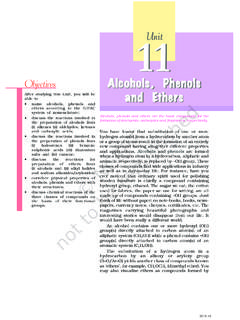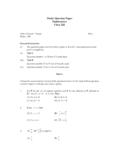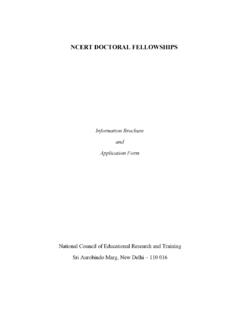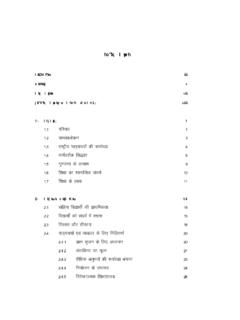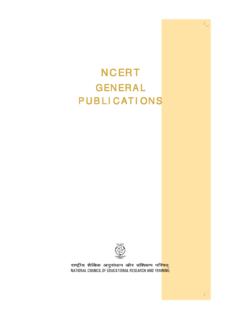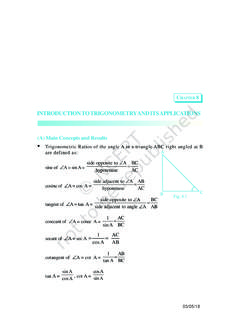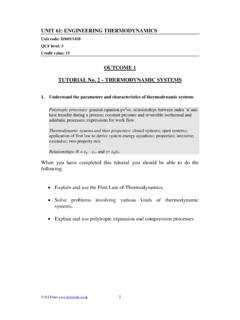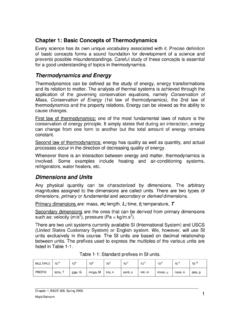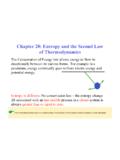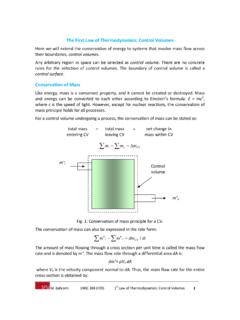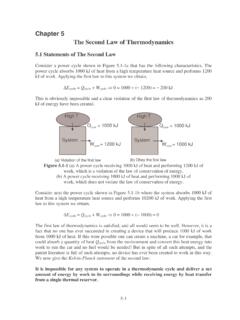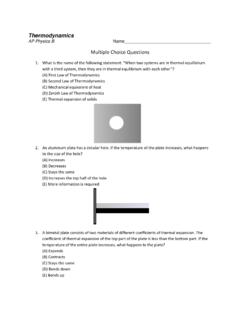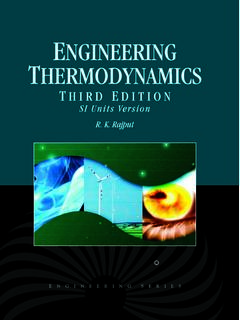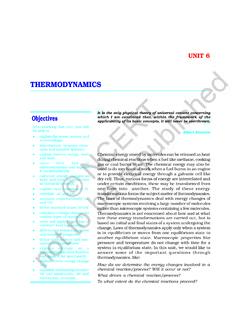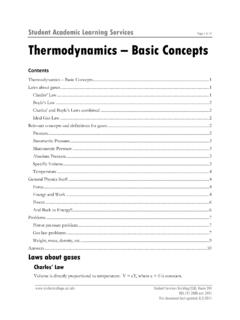Transcription of THERMODYNAMICS - NCERT
1 160 CHEMISTRY. UNIT 6. THERMODYNAMICS . It is the only physical theory of universal content concerning which I am convinced that, within the framework of the applicability of its basic concepts, it will never be overthrown. After studying this Unit, you will be able to Albert Einstein explain the terms : system and surroundings;. discriminate between close, open and isolated systems;. explain internal energy, work Chemical energy stored by molecules can be released as heat and heat; during chemical reactions when a fuel like methane, cooking state first law of gas or coal burns in air.
2 The chemical energy may also be THERMODYNAMICS and express it mathematically; used to do mechanical work when a fuel burns in an engine calculate energy changes as or to provide electrical energy through a galvanic cell like work and heat contributions dry cell. Thus, various forms of energy are interrelated and in chemical systems; under certain conditions, these may be transformed from explain state functions: U, H. one form into another. The study of these energy correlate U and H; transformations forms the subject matter of THERMODYNAMICS . measure experimentally U The laws of THERMODYNAMICS deal with energy changes of and H; macroscopic systems involving a large number of molecules define standard states for H; rather than microscopic systems containing a few molecules.
3 Calculate enthalpy changes for THERMODYNAMICS is not concerned about how and at what various types of reactions;. rate these energy transformations are carried out, but is state and apply Hess's law of based on initial and final states of a system undergoing the constant heat summation;. change. Laws of THERMODYNAMICS apply only when a system differentiate between extensive and intensive properties; is in equilibrium or moves from one equilibrium state to define spontaneous and non- another equilibrium state. Macroscopic properties like spontaneous processes; pressure and temperature do not change with time for a explain entropy as a system in equilibrium state.
4 In this unit, we would like to thermodynamic state function answer some of the important questions through and apply it for spontaneity; THERMODYNAMICS , like: explain Gibbs energy change ( G); and How do we determine the energy changes involved in a establish relationship between chemical reaction/process? Will it occur or not? G and spontaneity, G and equilibrium constant. What drives a chemical reaction/process? To what extent do the chemical reactions proceed? 2021-22. THERMODYNAMICS 161. THERMODYNAMIC TERMS be real or imaginary. The wall that separates the system from the surroundings is called We are interested in chemical reactions and the boundary.
5 This is designed to allow us to energy changes accompanying them. For this control and keep track of all movements of we need to know certain thermodynamic matter and energy in or out of the system. terms. These are discussed below. Types of the System The System and the Surroundings We, further classify the systems according to A system in THERMODYNAMICS refers to that the movements of matter and energy in or out part of universe in which observations are of the system. made and remaining universe constitutes the surroundings. The surroundings include 1. Open System everything other than the system.
6 System and In an open system, there is exchange of energy the surroundings together constitute the and matter between system and surroundings universe . [Fig. (a)]. The presence of reactants in an The universe = The system + The surroundings open beaker is an example of an open system*. However, the entire universe other than Here the boundary is an imaginary surface the system is not affected by the changes enclosing the beaker and reactants. taking place in the system. Therefore, for 2. Closed System all practical purposes, the surroundings In a closed system, there is no exchange of are that portion of the remaining universe matter, but exchange of energy is possible which can interact with the system.
7 Between system and the surroundings Usually, the region of space in the [Fig. (b)]. The presence of reactants in a neighbourhood of the system constitutes closed vessel made of conducting material , its surroundings. copper or steel is an example of a closed For example, if we are studying the system. reaction between two substances A and B. kept in a beaker, the beaker containing the reaction mixture is the system and the room where the beaker is kept is the surroundings (Fig. ). Fig. System and the surroundings Note that the system may be defined by physical boundaries, like beaker or test tube, or the system may simply be defined by a set of Cartesian coordinates specifying a particular volume in space.
8 It is necessary to think of the system as separated from the surroundings by some sort of wall which may Fig. Open, closed and isolated systems. * We could have chosen only the reactants as system then walls of the beakers will act as boundary. 2021-22. 162 CHEMISTRY. 3. Isolated System of the system. It may be chemical, electrical, In an isolated system, there is no exchange of mechanical or any other type of energy you energy or matter between the system and the may think of, the sum of all these is the energy surroundings [Fig. (c)]. The presence of of the system.
9 In THERMODYNAMICS , we call it reactants in a thermos flask or any other closed the internal energy, U of the system, which may insulated vessel is an example of an isolated change, when system. heat passes into or out of the system, The State of the System work is done on or by the system, The system must be described in order to make matter enters or leaves the system. any useful calculations by specifying These systems are classified accordingly as quantitatively each of the properties such as you have already studied in section its pressure (p), volume (V), and temperature (T ) as well as the composition of the system.
10 (a) Work We need to describe the system by specifying Let us first examine a change in internal it before and after the change. You would recall energy by doing work. We take a system from your Physics course that the state of a containing some quantity of water in a thermos system in mechanics is completely specified at flask or in an insulated beaker. This would not a given instant of time, by the position and allow exchange of heat between the system velocity of each mass point of the system. In and surroundings through its boundary and THERMODYNAMICS , a different and much simpler we call this type of system as adiabatic.
